#But it means it can be better polished and revised now
Explore tagged Tumblr posts
Text
I didnt write or draw much yesterday but im happy because, almost at midnight, i managed to draft half a story sequence in 15 pics 🎉
... lets see how and when i do the next part LMAO 💥
#windy squeals#I have that thing rotating on my brain for almost three monts i think?#Feels nice to actually have it out even if in a very sketchy scratchy form#But it means it can be better polished and revised now#When something lives only in your imagination you cant edit or work over it until its concrete on a canvas or piece of paper
2 notes
·
View notes
Note
hey corny. so i always see people recommending to outline their story before starting it, but could you talk a little bit more about what that means? what is an outline and how do you structure one? how long are the ones you write, depending on the project? do you focus on plot beats or feelings? how specific do you get? can u recommend any readings for learning more?
up front i don't have any resources for this, only experience. and outlines feel like one of those things where it's like... there are a million ways to do it and the way that works for me might not work for you. i have a friend who writes out all his ideas on index cards and that, for me, is insane. but he's also a better writer than me so who can say what is right or wrong.
anyway an outline is essentially a sketch but for a story. you go through the whole thing, start to finish, and figure out what goes where and what happens when. the idea is that this is the stage where you work out all the big picture stuff and make sure it all fits together, now, and not after you've drawn twenty pages and suddenly go "wait shit that doesn't work" and have to do it over. it is much easier to delete and rewrite a paragraph than to redraw several pages.
doing anything more, ie including dialogue or feelings, depends entirely on how useful that information is to you at that point in the process and whether the purpose of the outline is for your own guidance, or so somebody else can tell what you're trying to achieve.
this got really long with multiple examples
here is an excerpt from the original outline i used to pitch Hunger's Bite to publishers. this one had to be polished to a professional standard, because somebody else was going to read it and decide whether they wanted to give me thousands of dollars to tell this story. (also several of the details are no longer accurate. for instance it now takes place 9 years earlier lmao)

this paragraph represents the first eight pages of the book. the final book is 264 pages long, and the outline was 12 pages of paragraphs as dense as this one.
it establishes where we are, who's there, and what they're doing. i describe their conversation, but i don't commit to the dialogue. i will occasionally include snippets of literal dialogue, but usually only if it's Important Dialogue, or i just don't want to forget a good idea i had while outlining. it's not expected at this step.
an outline written as part of a pitch to a publisher should tell the whole story, with all the important details, and leave nothing ambiguous. they need to know the tone, shape, and the arcs. no secrets! all the spoilers. outlines for yourself should do this too, but outlines for others need to be as clear about your vision as possible. again, an outline like this exists for the purpose of getting you paid thousands of dollars. you should write it like that.
in comparison, here's an excerpt from the outline i wrote for revisions to my WIP prose novel, so i could show it to my agent (who already read the draft) to be like "do these changes sound good?" i'm not selling it to anyone yet, just making a guide so i can have a conversation about it. so it doesn't need to be neat, it just needs to be functional and clear. the first chapter was entirely new stuff. the second bit was just writing down what was already in the chapter that existed.
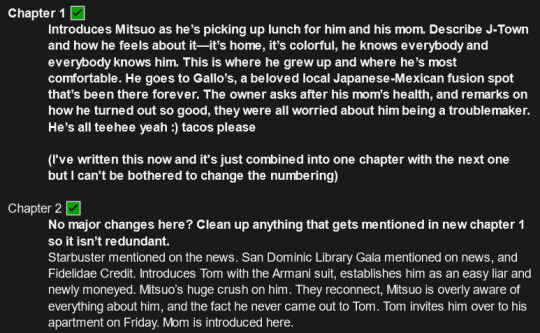
i have historically been very bad at outlining things when i don't think i "need" to, and only wrote this one after having written like 60k words of the book without any overall plan. i gave what i had to my agent for feedback and then sat down and figured out how i could apply it. it's made the whole revisions process significantly less daunting. now i have a checklist for things i need to do! this one was a paragraph or two for each chapter, with the ones that needed a lot of rewriting given a bit more detail.
lastly, here's a bit of the outline for the first roger crenshaw book. i was the only person who had to see this, and since the story was planned to be very short i didn't have to worry about a whole lot. as long as i knew what was supposed to go where, it would work. honestly it's not a whole lot different from the previous example.
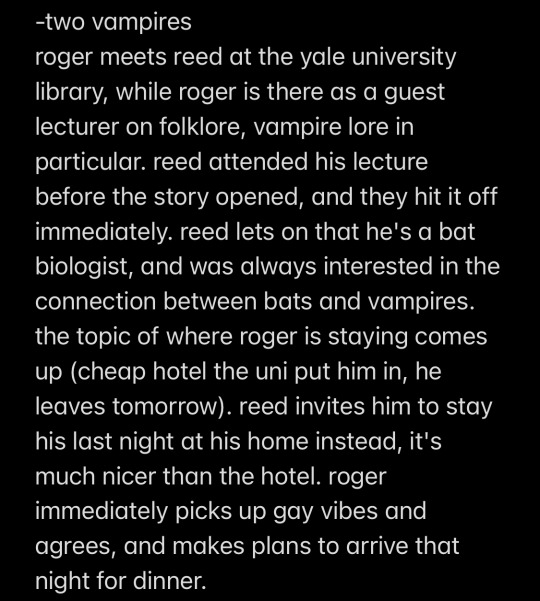
this one was like five paragraphs and it did the job, and this story was like 15k words. you only need as much or as little as will actually help you on the page.
basically if you take nothing else from this, it's that there are multiple ways to write an outline, that it does not need to be perfect if you're doing it for yourself, and that it only needs what you think is important (unless it is for other people. then it should have everything). and also it's a good idea to do it earlier in the project than after you've written 60k words or drawn--jesus christ i got up to 12 chapters in never satisfied? it's amazing i didn't quit sooner
143 notes
·
View notes
Text
Beta Reading, Workshopping, and Peer Editing for Indie Writers: a Guide
Beta reading is a term you might hear tossed out as a vague buzzword, kind of like how people talk about "character development" and "worldbuilding"; I've made a bunch of posts to demystify words in that latter category, but beta reading is a different type of term. Where those latter words and their ilk are terms of craft, things we can discuss in theory ("this is how I think characters are developed best"), beta reading is about a novel after its first draft and first wave-ish of edits. Pretty much everything before and after the production of a novel or story is purely up to what works best for the writer, so this post will introduce beta reading if it's new to you, and I'll give you my process if you want to tinker with it!
Beta reading is when interested readers work through your polished manuscript and make workshop comments so you can make an extra wave of edits. Publishing houses usually have two waves of this type of reading--alpha reading (AR) and beta reading (BR). If you can find enough people to alpha read for you (and you want alpha readers), go for it! But if you're confident in your grammar, your ability to craft a scene and characters, and the other formalities of creative writing, alpha reading isn't a requirement (as an indie. If you ever query your work to a house, it'll probably go through alpha reading).
Alpha reading is to catch grammar and syntax slips, mischaracterizations, character development that doesn't add up, excesses of adverbs and adjectives, and other craft faux-pas that the average reader wouldn't catch. Your alpha readers should pretty exclusively be other writers.
Beta reading is to gauge what your audience is thinking or feeling while they read your work. If your beta readers want to make alpha reading comments ("I don't feel like [character] would do that here"), that's A-okay, especially if you didn't have alpha readers, but that shouldn't be your chief concern with your betas. These are your audience surrogates! The job of beta readers is to tell you what they think or feel: "I like this," "I don't like this"; "This paragraph hit me hard"; "This word is confusing"; etc. If they add more words to their comments, that's A-okay ("I like this because these words go well together" or "This word is confusing--does it mean X or Y?") but not necessary! If your beta readers are your audience and not people who really get how writing works, then you should be taking any reasonings in their comments as loose, loose suggestions. Maybe those words that go well together to one reader feel, as you look at them a second time, cliche. Or perhaps the confusing nature of a word or phrase was by design. In any case, try to see your beta readers as a "live audience reaction" and not a "live reactionary critique."
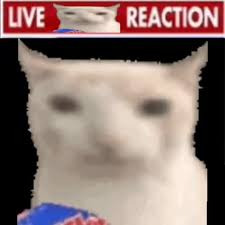
One aside about alpha/beta reading: "this is bad" and "this is good" comments are toxic and should be avoided at all costs. Tell your readers to avoid these before they start writing. No good can come from these. Even "I don't like this" and "I like this" are worlds better, though still not great. But absolutely warn your readers against using objective blanket statements like "good/bad" as they read.
Now that we've laid the foundations, I'll go into my own process so hopefully everything above makes more sense.
Before I give my manuscript to beta readers, I go through 2-3 waves of revision on my own. After I finish my first draft, I wait about a month to let the dust settle, to gain at least a little emotional distance from the project so I can look at it a little more objectively. Then, I read it through, revising for content: cut this scene, add a scene here, chop paragraphs and sentences, add paragraphs and sentences, move this chapter here, make sure this character actually functions as he should in the narrative, etc. These are my macro edits.
Then I let it sit a week or two and go into line editing: punctuation and syntax, word choice, tweaking figurative language, etc. Close pruning of your work. Filing your nails after you've clipped them.
The third read-through is at a normal reading pace, as if you were a reader, to catch anything that may have slipped past during your close edits and revisions. This third read-through is likely the first time you've read your manuscript as it should be read--a book! This step, then, is a victory lap, but it's also one last troubleshoot. You might not find the errors in a computer program until you run the program. So too it is with writing.
This is a lot of work! You might want to relegate these tasks to your readers, but DO NOT!!! If you're still heavily revising and editing your work, don't let your readers to the table. This is your work and your story, and outside influence will stray it from what you want. Own this. Buckle down. Read.
Once you've got your polished draft, it's time to contact your readers! I would recommend 4-6 readers total unless you think you can handle more cooks in your kitchen at a time (I cannot). I typically just ask some of my friends to beta for me. Here's an example text:
"Hey all! I finished that book about church camp a while ago and was wondering if you'd beta read for me! Basically, I'd just need you to read through the book and make comments in the sidebar whenever you like something, don't understand something, are excited or intrigued by something, or other general impressions. You can comment however often or little you feel comfortable with--some people make one comment a chapter, others make multiple comments a page--anything works great. Really all you shouldn't comment are blanket statements of "this is bad" or "this is good," but feel free even to say stuff like "I like this" or "I don't like this." Just avoid objective language when possible.
I don't have any money for this, so sorry in advance, and if possible, I'd love for all of my beta reading to be done by the end of summer.
Let me know if you're down or not! :)"
I really have had readers comment that much and that little on my manuscripts. This is normal. If your readers are supposed to comment whenever something in their attention triggers, different readers' attentions will trigger differently.
It's also a wise idea to form your beta reading group (again, especially if you aren't doing a wave of alpha reading) as a mix of people from different backgrounds and writing experience. My church camp novel group is below:
Person A who went to church camp with me, is into poetry
Person B is into fanfiction, little church experience, mindful of social issues
Person C has little church or writing experience, mindful of social issues
Person D is very into writing, pretty into church
Person E is very into social issues and church, not a writer
I would advise to find a similar balance of people who are into your subject matter and those who aren't.
It's also helpful to give them a timeframe to read by, and make this longer than they need. I gave people ~two months for my ~60k-word novel.
Also, as a little incentive for your readers, plan something for when everyone's done! A post-beta party! Something like this will also encourage you through the process :)
Once you have your betas' comments, it's time for one last wave of revisions. Compile these comments however you like, and start tweaking. I like to have each beta's document open so I can cross-reference while I work through my own doc. And remember: these are audience comments, not writer comments (unless you explicitly brought writers on). If someone says something confuses them, that might just be their cross to bear. If none of your other betas were confused by it, or if one of your betas compliments the same section, it may be worth ignoring that first comment. Try to rule with the majority when you can, and take everything with a grain of salt. "I don't like this" doesn't mean it needs to be changed. It means you should figure out why that reader doesn't like it.
If you have any questions, my asks are open! Again, this is a pretty open concept where anything works as long as it works for you, so don't feel pressured to "get it right." But if you have any questions or suggestions, I'm all ears :)
Hope this helps!
#writeblr#writing#writing advice#fanfic#writers on tumblr#creative writing#bookblr#writing questions#booklr#writerscommunity#reading
37 notes
·
View notes
Text
I can't write... I can't write...
I can't write while Amane-chan is holding me upside-down!
Let me go! Don't you want me to write that nice, fluffy piece as a break?
She doesn't trust you at all not to turn it into angst
I... uh...

If you want a little perspective...
Amaneverse Whumptober wrecked my sleep schedule for all of October. (I mean, it's not much better now, but that's on me.) I posted it in full on November 5. (Well, Nott's chapters and one spoiler chapter are omitted)
(Bad Haircut was a silly little breather (that makes Amane cry), but then I spent hours scrutinizing a single line. Oops.)
Then I worked on Fright Walk (formerly called "Haunted House") because it was the only Amane-centric piece that wasn't super angsty (well, there's the plasma ball scene-). I posted it on November 15. Written in ten days at most.
Afterwards, I outlined "Holding Hands", the fluffy piece in which Mahiru holds everyone's hands...
...and then shoved it aside when I got the idea to write about Amane dying in Mahiru's arms. Monsters came out. It was written in the dead of night and meant to be privately shared with the Milgramblrgram folks, but then I decided to polish it and post it. That was five days after "Fright Walk". That was- What do you mean it was less than three days ago???
I've gotten all the "priority" ideas to at least the outline stage. "If you had been there" (That's a long outline...) "I'm so sorry" (Been done since April, but I need to majorly rework it) One of the OoA timelines (need to revise the text) Cry - Falling/Trapped (That one's particularly cruel... Sorry, Amane, the "fluff and angst" fic is veering into just plain angst territory) Milgram's Turn To Die - The First Trial (basic outline) Holding Hands - (Yeah, yeah, I just need the motivation. Amane, let me go...) And some surprises :D
I've got another snippet for "Order of Attack" coming up, but I need to fix the voice of it... I sure hope I can get that figured out soon.
...
What do you mean I did all that? It didn't feel like a lot until I actually sat down and enumerated all this.
My true punishment for writing angsty fic... Burnout.
9 notes
·
View notes
Text
DotNW Draw-a-thon Days 25-31
It's been a wild ride! But I think I made it out more or less unscathed!


I'll do a masterpost tomorrow along with some final thoughts. But for now, enjoy some content for the best boys. I can't get my Richter's quite right, which was what I was afraid of. But they're not bad and I will see if I can fix them into something I like better in more polished revisions. In the meantime, enjoy. DotNW deserves more love than it got. It's definitely not Triple A GOTY never seen before material. But it's way better than people give it credit for and if it wasn't stuck in the shadow of the original Symphonia, I think people would have enjoyed it more.
I started replaying it to try to get better reference shots and the only complaint that I have so far is "why is this game so laggy and grindy? Just let me befriend all the monsters and let me level faster!" Which is less of a "this game is bad" issue and more "I'm an experienced player that can't access my old save files because of personal technical problems so I'm impatient." And I'm pretty sure the lag is mostly "This game was made to run on the Wii, why are you running it on the Wii U?" But it's also just me being impatient probably. "What do you mean I have to wait 3 seconds for a fight to load?"
But for real. I'm actually giddy about some of the worldbuilding they put in that I never noticed before, little details. I think my only main complaint that isn't an impatience thing is how some of the skits are locked behind events with random components, i.e. trying to fail several pacts in a row which is at least partially determined by the luck stat which you can only reset by sleeping at an inn and you cannot otherwise control. Yeah, anyway, less yammering, more doodling.
I think I will eventually get around to doing all the monsters. But I might take a break for a while.
Shout out to @catcantnavigate for keeping up! I loved seeing all your work throughout this event! And shout out to @aerypear for hosting/coordinating. I hope to see more DotNW stuff trickle out! Game is not a masterclass of innovation or storytelling but it is SERIOUSLY underrated and one of my favorite games of all time and definitely the source of my top favorite characters for real.
#DotNW#ToS2#my art#art by GKD#Richter Abend#Aster Laker#Emil Castagnier#Centurion Aqua#Ratatosk#Centurion Tenebrae#Pontus#Monsters#Polwigles
13 notes
·
View notes
Note
I love your art! So, I was wondering if you have any drawing tips you could give?
Hiii thank you so much for the kind words, I am really glad you like it!!! :’3
As far as tips, this is kind of a broad question that I think it varies widely in terms of how you want your art to look. Personally, my main priorities are fluidity and character interaction, so that’s what I focus on even though it means I don’t really draw elaborate backgrounds and such. I’m sure I could become better at other things if I tried, but I’m not a professional nor am I trying to be, so I just focus on what’s fun to me.
Putting the rest of this under a cut bc it's gonna be long
As for actual advice, I have three big rules which I think have helped me continue to enjoy drawing as long as I have, which is the most important thing to me. I started drawing as soon as I could hold a pencil, and it's been my main outlet for good and bad times throughout my whole life (I am 26 now). Other people liking what I draw is a treat, but as long as I have fun, that’s ultimately what matters to me. That said, please keep in mind I am speaking solely for myself here since everyone draws for different reasons and in different ways.
The first thing is avoiding perfectionism at all costs when drawing, because it sucks the fun out of the process and ruins the visual fluidity in whatever I’m working on. An example of this is that I don’t like to go back and revise lines I’ve already placed, because the more I try to polish them, the stiffer they look. Even in digital art I try to roll with mistakes instead of erasing, or just completely undo the line I placed and try again.
The other thing is something I actually picked up from dog training which is arguably my biggest passion in life. There’s a common saying amongst dog trainers: No “one more time” — which essentially means that when find yourself thinking “one more time,” you need switch gears immediately and do something else because you have hit your frustration threshold and every attempt from then on will be frustrating & counterproductive for both you and the dog.
This applies to pretty much every aspect of life for me, but it made a huuuge difference when I started to consider it within the context of drawing. If I just stop whatever I’m frustrated with and go back to it later, 99% of the time I can pinpoint exactly what bothered me and how I could have fixed it. I’m typically not the type to work on something over various sittings, so even if I don’t finish the picture I was working on after coming back to it, being able to pinpoint what went wrong about it is a lesson I can apply to whatever I work on next.
The third rule ties into the last one, which is just not pushing myself. If I’m not having fun with a drawing anymore, I’m not going to force it. If it’s not coming out the way I want it to, I’m not gonna push it. Any time I've pushed through frustration to finish something, I wound up disliking how it came out. This isn’t really realistic for someone who is a professional (or aiming to be), but for me who just likes drawing anime characters for fun, it’s perfect. Because of this, I haven’t dealt with constant art blocks like I used to. I definitely still have them, but they're usually brief and not distressing to me. I feel like I’ve kind of stagnated the past several years, but at the end of the day I have a blast when I draw and that’s all that matters to me!
There's a common sentiment that everybody hates/is embarrassed of the things they drew in the past or even right after finishing and/or posting them. But it doesn't have to be like that, and imo it shouldn't. I think that just means there are some things about one's process and mindset that need to be reflected on.
Hopefully that helps somewhat, but YMMV if your priorities are more in the vein of constant improvement and/or being a professional :] I know this was kind of an abstract response, so if anyone has specific questions feel free to ask lol
23 notes
·
View notes
Text

Edit: Revised some things, original version under the cut for posteriority ___
At long last, a first draft of Jos's redesign!! \o/ This took way longer than I would have liked because I was dreading trying to draw what they were leaning on (I started this before the last sorXa drawing, if you can believe it, which is why that and the Cohost memorial were on 3 by 5 notecards), but I eventually opted to demote it to concept art instead of a polished piece just so I could make use of all the effort that'd already gone into it.
Some design notes:
This headset was originally meant to replace their old one, but as previously mentioned that would have meant losing a bunch of homages to other characters, which I decided wasn't worth the upsides of this version. I might still keep it as something they use when doing mechanical work as a sort of welder's mask version of their normal headset, but I intend to make the revised version of their usual headset much closer to its old design. Or maybe it won't be a headset, but a single earpiece with goggles or something? Who knows! I sure as hell don't!
Their hormonal implants are a little more low-profile now, and one on their right arm has been moved to the other side of their abdomen, partly inspired by the fact that I've since started weekly E injections (and my doctor has instructed me to switch sides each week), and also because...
They now have a tattoo of the Clover logo where their implant used to be. I've admittedly never been much for tattoos, but I figure they already have one on their lip (so they're clearly not averse to getting them), it's almost kinda weird to have a cyberpunk setting where none of the major characters have any noticeable tattoos in this day and age, and it brings in some extra green in a way that makes more sense than the old design for their implants IMO. Also I think I like the idea that Clover didn't really have a good emblem until sorXa showed up and designed this one, which means this is a tattoo of their girlfriend's art, and I think that's cute <3
As previously mentioned, the work pants are based on some designs from Dovetail Workwear, but I think none of the details are necessarily unique to their designs. Just thought it'd be worth mentioning if anyone wants to look through their catalogue for design inspiration like I did, or to like. fuckin'. buy pants like this? I can't vouch for the quality though so shop at your own peril.
Also regarding the workpants: that grey layer over protective material is ethermail, the same stuff used in a lot of the armor designs I've done for Machine at Arms
Their wristband has migrated to their other wrist. No idea if it'll stay there, not even sure it'll stay at all, we'll see. Maybe I'll replace it with yet another tattoo, even! You'll find out shortly after I do. That's just how it is on this Clara of an artist(...???) (a warning klaxon blares as a hit squad closes in on my location).
As an aside, I've also since opted to stop referring to their gender as "demiwoman" and instead have decided on "woman+", which I think describes them better? They're 100% woman, but also they've got more going on on top of that. That's right, they have bonus gender. They're just that cool. B^) (I'm totally not biased as someone whose gender dealy is similar to theirs, just using she/her instead of they/them like Jos does. Totally. >__>)

#Dr. Josette “Jos” Bonheur#Machine at Arms#Aqueous OC#Aqueous sketch#concept art#character design#Aqueous illustration#Aqueous art
4 notes
·
View notes
Text
prose and poetry and other experiments
I don’t really do writing advice or instruction posts, at least not at this point in my life. But I’m on the verge of (hopefully) finishing a one-shot fanfic that’s made up of nine poems, and then going to my writing program residency in a little more than a week, and it’s made me think about the value of like… just experimenting with writerly things that are outside of my comfort zone (or even the things that are a little terrifying) and seeing what I learn from them.
Like poetry, for instance! I used to think of myself as primarily a prose person, like maybe I’d get inspiration once every seven years and dash off a lovely poem about my feelings about spring. After that then I’d go back to writing prose like a normal person untouched by the poetic muse. But through my local bookstore and my writing program I learned more about verse novels, and started to love them. I began to experiment with telling stories in verse just because it felt like fun, and because a lot of my classmates were also experimenting with it. In my second semester, I worked with a poet as my advisor, and ended up trying out two historical novels in verse, which meant writing so many poems. Some were brilliant! Others were just placeholders in need of revision! Nonetheless, I produced a lot of text, and I was proud of what I’d done.
Now, I haven’t become exclusively a verse novelist. My creative thesis is probably going to be a hybrid of verse and prose, and I’ve certainly written things that continue to be all one or the other. Some of you might say, well, I only want to write prose, so what’s the point of trying to write verse? But here’s the thing: spending a lot of time writing in verse, and doing it with a sense of curiosity, actually made my prose better too. Like I think I have a better sense of where scenes should begin and end now, and am better at parceling out exposition. I can write characters as living in their bodies much better, and I know what sensory details go into a scene to tell us about a character’s emotional state. These were all things I struggled with immensely before I got into verse, and verse made me better at them. I’m sure writing one-act plays or something also could have helped with some of that, but my point is, sometimes going outside the very intentional parameters you created for yourself can actually help you.
So yeah, I don’t want this post to solely be about poetry. You can experiment with lots of different craft elements and genre conventions, and just fuck around for the hell of it, and discover yourself as a writer. Like if you always write in present tense and see it as your thing, it’s worth trying a story in past just to see how it feels. Or if you’re find you’re too distant from your protagonist in third person, try scooting into first person—or even second person—just as an experiment. It doesn’t mean you have to write the final draft of the story that way but it can maybe show you some things about the character you wouldn’t have picked up on otherwise.
In fanfiction, sometimes this means breaking with the “house style” of fanfic that you’re used to, or trying out a different house style. (I would argue that there are sometimes “house styles” that show up in different fandoms or subgenres of fanfic.) Or writing from the POV of the character you’d “never” write from, or writing a pairing you wouldn’t normally write, or something. Again, I don’t mean you have to write a fully polished multichapter fic about something that’s not your primary area of interest and then post it on AO3, but giving yourself a chance to write a paragraph or two (or a poem!) and just letting yourself play in a new sandbox for ten minutes… can be fun and enlightening actually. Maybe you’ll discover something new you like, or maybe you’ll discover something new about something you already like, which is also valuable.
The expression is “fuck around and find out” and I think we usually see that expression as threatening. But when it comes to writing, giving ourselves permission to fuck around can actually help us find out a lot about ourselves as writers and strengthen our craft.
Also, it’s fun, and fun is absolutely something I endorse when it comes to writing.
3 notes
·
View notes
Text
10. Editing and Formatting
So, you’ve written your first draft? Amazing. I’m so proud of you, and I’m so sorry to tell you that this is the point where writing becomes boring. Wait? You thought you’re finished now that your draft is done? Oh, well—it’s really not like that. Actually, this stage of writing is not only the most tedious but most time consuming, because now you have to go hunt for typos and bad grammar, redundant words and irregular spacing. It might just as well happen that you'll find yourself revising your finished draft yet again. I say this is tedious work, but you actually just keep improving your draft, which is a very good thing! Edit your work, constantly. If you read your draft and think “Actually, I could’ve written this or that a little differently, it would’ve sounded so much better!”: Change it, then, honestly—even if it takes half an hour. You’ll regret it otherwise.
Example:
I edit my work in three stages:
I read the entire draft just like you would read another writer’s fic. I’m not looking for typos and all that, yet, though if they’re obvious and easy to fix I do that right away or mark them for later. In this round, I’m checking for awkwardness or inconsistency. Things that sound bad or could be better. What really worked for me was being conscious of how I read. I’m aware not everybody has it, but I do have a reading voice, meaning: I hear a voice inside my head while reading. When I’m editing, I try to be very conscious of what that voice narrates. So when there’s a sentence and the narration in my head doesn’t match the actual words written on the page, I will usually change the sentence to what I subconsciously thought the sentence would be like written out. Pretending to be the reader and not writer of a draft can be very helpful, because you have to think about what a reader who doesn’t know the piece you’ve probably read X amount of times by now would expect. In 9/10 cases, my sentences improve.
In this round I re-read the entire draft word for word. Depending on how long my draft is, this can take forever. Now I really get out the magnifying glass and sift through my draft, hunting for typos and such. Nothing spectacular, just really tedious work, but generally worth doing.
Repeat Step One, but this time I do it after I have copy and pasted my draft to where I eventually want to upload the piece— tumblr or ao3. I save the post as a draft and then re-read it. Two things happen: a) my draft looks different than on my writing program; this has me more alert. b) I see what my draft will look like to readers; helps me get into the reader-perspective. I’m always astonished to see how many more typos etc. I missed the other X times I checked for them! After I fixed them, I usually prepare my post for posting.
There are some online programs that can help you check for grammar and typos, but don’t completely rely on them—especially since free versions of them are not really made for creative writing projects. They just don’t get art, ok? What I can warmly recommend, though, are beta readers. They’re real people who get to read your draft before you publish it. They can help you check for grammar and typos and all the likes, but they can also give you wonderful feedback and tell you what you might improve story-wise. While your beta is more than happy to help you edit your draft, let’s talk about formatting.
Before you share your work with the rest of the fandom, you want to make it look presentable—polish it, so to speak. Your draft can be as good as could be, but it’s pretty exhausting to read a piece that looks bad and it will scare potential readers off. Here’s a very quick list of things you want to avoid:
You don’t want your draft to be one single, long paragraph. Line breaks are your friend. As a rule of thumb: If there’s a new scene (imagine a cut in a movie), you start a new paragraph. Same goes for dialogue—whenever there’s a new speaker, you insert another line break.
excessive punctuation (e.g. “No!!!!!!!!” He cried.)
weird fonts (choose something that’s easy on the eyes)
overuse of highlighting or emphasising (bold or italics)
bad grammar and punctuation
If you want to get a feeling for this kind of thing, open a novel and just look at a random page for a moment. There’s a pattern I’m sure you’ll soon recognize—try to recreate that in your own writing.
Next: Polishing your Post
Masterlist
2 notes
·
View notes
Text
Progress Update #46
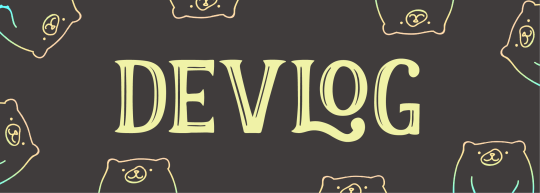
The poll overwhelmingly favors the dark blue over the gray blue for Soul Shattering Star's textbox. As I was finishing SSS's UI, I quickly realized there's a problem. It's the exact same color that I'm using for Steeped in You. Same color AND opacity.
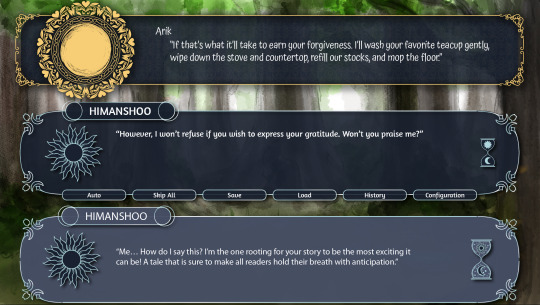
I can't be out here dressing my children the same!! That leaves only one thing to do: back to the drawing board.
I've been going through some sort of attitude problem, aka being very insistent on having a memorable and unique UI. Most textboxes for VN tend to use some off-black, off-white, or off-blue backing. Of course, I understand why. These colors are easy to work with to make both aesthetic and legible textboxes.
And as many shades and tints of the same color there are to work with, I can't help but see it all as the same. In my case as a budding UI designer, I think it's especially egregious how much blues and greens I favor. There are three games I'm juggling between, and I find it incredibly upsetting if their UIs can be mistaken for each other.
I think a large part of my issue stems from the fact that my UI designing skills are rapidly outgrowing my satisfaction with my existing work. Truly...with improvement comes growing pains. It also might be that I don't yet have the exact understanding of what's wrong with the old UIs, so my brain latches onto these things that I can see, such as color palettes and font choices.
Some time last week, I came across this message, and it helped put things into perspective.
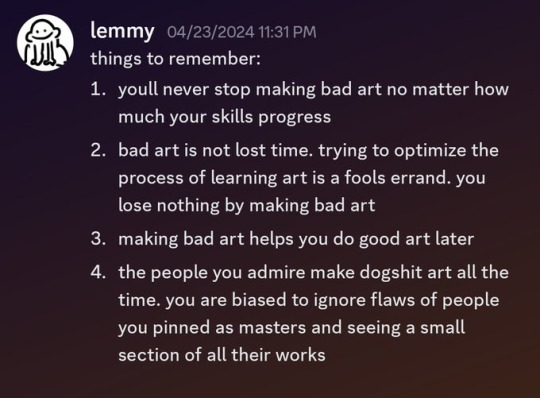
As a perfectionist, being satisfied with "bad art" is still a point of struggle. It's not realistic to constantly be revising my UI every time I see flaws in it, but I think undergoing two major revisions per game is about the current expectation for me.
In Steeped in You's case though, I decided to swap out the blue for a brown. However, there's about one too many brown-yellow combinations for food/cafe-related UIs, so that meant I couldn't just be content with that simple fix. Still, I needed to revamp the UI anyways to make it fit the current VN coding template, so it was a good opportunity as any to get all the fixes in now.
I went back to the old color palette and played with different color combinations. There were plenty to choose from when I swap primary and accent colors, but very few that actually worked. In the end, I decided to use pink to replace the yellow.
Surprisingly, I didn't go overboard on fixing everything. All I did was replace the fonts (which took a while to find) and colors!
Title Screen before and after:
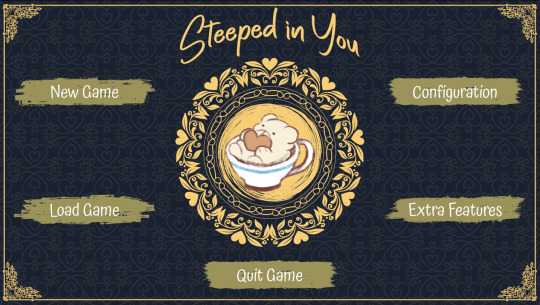
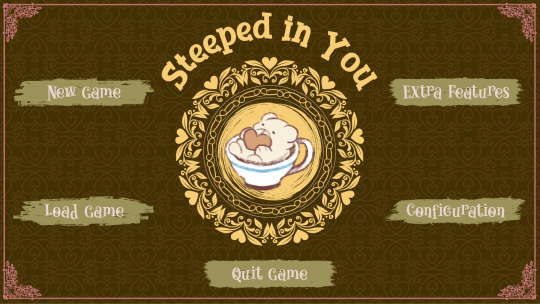
Choices before and after:
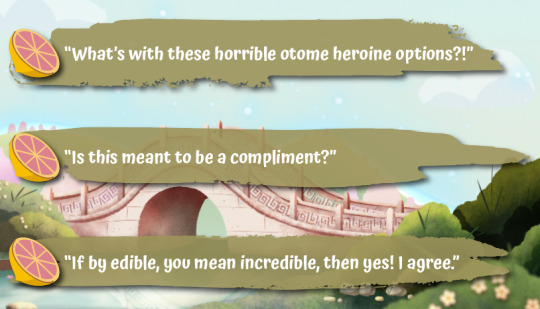
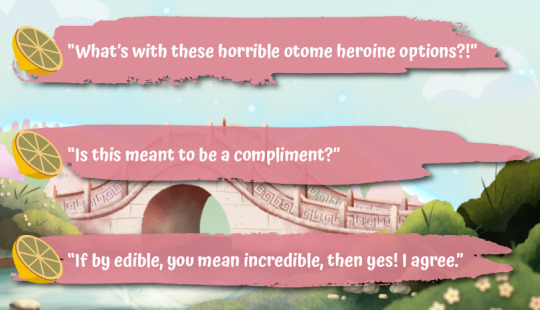
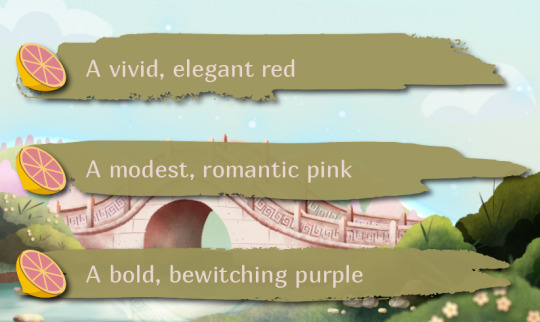
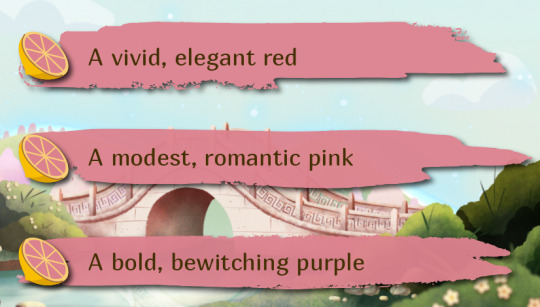
The choices screen is largely unchanged. Why change what ain't broke? Ahem...I'm deeply aware of the irony of me saying that as I do this whole redesign.
Even better, the fresh coat of paint on the textbox makes it look completely different even though it's the same color palette.
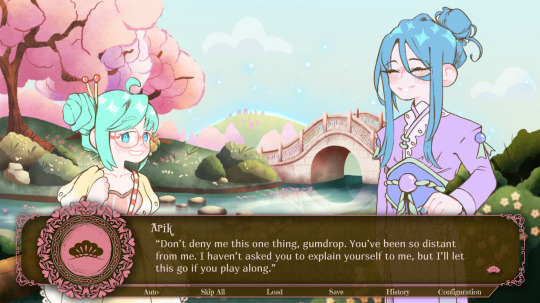
The configuration screens are where most of the changes are, and that's because of the VN template. It still needs some polishing, but I'm more or less satisfied with this look.
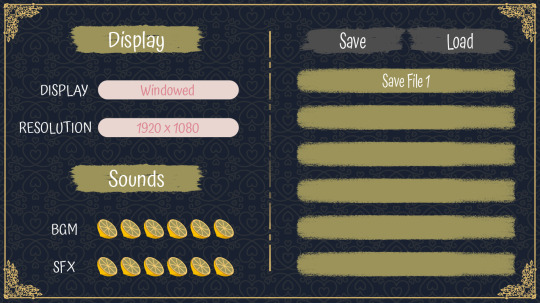
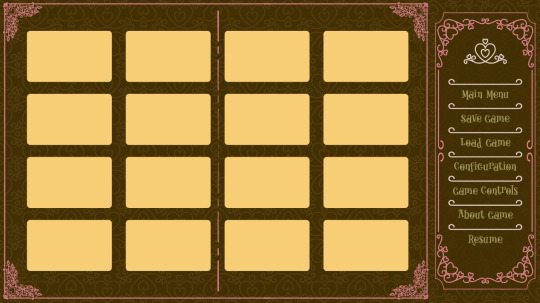
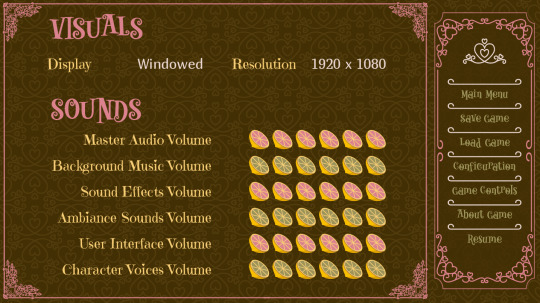
It's nearly May, and that means the date of my trip draws ever closer. My goal is to finish all the UIs I'm juggling, and then tick off at least one item on my list of coding tasks by May 3rd.
1) Figure out how to stop reading text from advancing when clicking buttons
2) Order the save files sequentially rather than alphabetically
3) Display star bars properly when loading save files
4) Animate certain menus
5) Find a way to call background effects
After that, I have to focus my attention completely on finishing the last bit of preparation for my trip. That means no devlog updates for a little while.
Catch y'all at the beginning of June!
#upcoming game#english visual novel#otome#interactive fiction#cyoa#oelvn#game development#ursine vision atelier#soul shattering star#steeped in you#devlog
2 notes
·
View notes
Note
Hi Jenn! An agent has had a full MS of mine for a bit. At this point, I genuinely don’t want to go out on sub with that MS. I have something else I would rather put out there. The thing is, I don’t know if that agent would be interested. I feel like another agent at their agency would be a better fit… How do I handle this? How do I say “Hey, you know that full? I don’t like it anymore!” Do I offer to send my new MS? What if they say no? Can I just withdraw it totally, then query the other agent with my new MS? I don’t want to mess up!
Thing is, I don't think it's really a matter of "messing up" -- like there's no "correct" way to do something like this. It's just not usually done. That doesn't mean you can't do it. I'm just saying, there's not a Right or a Wrong way, per se.
BEFORE YOU DO ANYTHING, I would ask you to actually look deep into your heart. There is a species of Author that gets sick of old manuscripts when they have a bright shiny new idea, and is quick to discard them so they can move on to the shiny thing. Which, OKAAAAY, to some extent, it's good not to be precious and cling TOO hard to something that really isn't working, but sometimes this comes across as being fickle, or just wanting to do the FUN part of writing and not the HARD part of revising/polishing/etc.
I'm not saying this applies to you! But... does it?
IF this is a pattern for you, you have a history of getting "sick of" old ideas, etc -- mayyyyybe just sit on your hands and see this through. See what happens with this full / this agent. If they pass, OK, no prob, move on, query their colleague with the new one -- if they end up loving that old one / wanting to talk, you can share the new one with them, go from there, etc etc.
Like, would you REALLY still dislike Manuscript A if the agent ends up loving it and thinking it can sell? (REALLY?)
IF this is absolutely not a pattern with you, you legit hate that old ms now, it's NOT "bright shiny new idea" syndrome talking, you don't want this old book affiliated with you at all regardless of what the agent thinks -- then sure, withdraw it and start from scratch with the new ms.
1 note
·
View note
Text
05/04/2025 What Flow (2024) Taught Me About Storytelling and Scope
In class, our professor mentioned the production process behind this year’s Best Animated Feature winner, Flow, and suggested we do some research on it—it might spark some inspiration. What makes Flow stand out is that it wasn’t made by a mainstream studio like Disney, Pixar, or DreamWorks. Instead, it came from an independent studio in Latvia. It’s a ground-breaking success for several reasons.
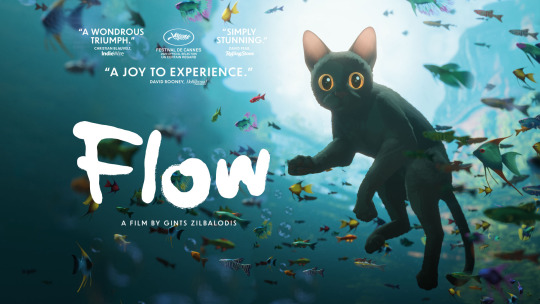
First, the film was made entirely using Blender, a free 3D software. For those of us in animation—especially small studios or solo creators with limited budgets—that’s incredibly inspiring. It proves that high-quality animated features can be created without massive funding or expensive software.
Second, due to budget constraints, the team had to work within tight timeframes and limited computing power, which meant they had to be extremely efficient. In interviews, the director explained that every element—modeling, lighting, textures—was designed only for what appeared in the frame. If something wasn’t visible, it wasn’t made. As a result, they had almost no deleted scenes. Every shot was essential.
These insights inspired me to consider using simple 3D modeling to test different angles. This would save time and help me feel more confident when drawing keyframes, especially regarding perspective or camera positions.
Another thing that stood out to me was Flow’s use of visual storytelling. Due to limited resources, the team maximized the storytelling power of every frame. Rather than relying on lengthy dialogue or flashy effects, they focused on conveying meaning visually. I’ve been thinking about how to do the same—using environment design and character performance to enhance the story, rather than over-explaining with dialogue. This also ties into my proposal’s core approach: expressing key concepts through visuals instead of spelling out themes with words.
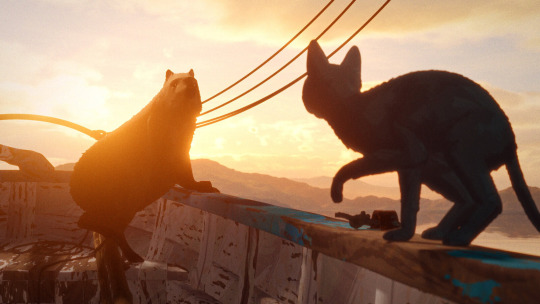
The production process behind Flow also made me reflect on how to better manage my own time and creative resources. In interviews, the director mentioned that they spent a lot of time upfront refining the story and storyboard. By making sure every shot had a narrative purpose, the production phase became more efficient. That really resonated with me—since I’m still in the concept development stage, locking down story beats and pacing early on could help me avoid unnecessary revisions later.
It also reminded me that when I work on keyframes and storyboards, I should identify the scenes that are crucial for character growth or emotional shifts and prioritize those. Instead of creating tons of concepts up front, I can focus first on what really matters to the story. This mindset might help me complete my Semester C goals more efficiently, while still delivering a coherent, polished project.
Lastly, during both class and tutorials, my professor suggested I consider the runtime of my project—whether it’s a short film or a full-length feature, a TV format or something else. Initially, I imagined a one-hour animated movie, but during the tutorial, my professor reminded me that pulling off something that long, solo, in a short time could be extremely challenging.
So now I’m exploring alternatives, like a TV-style short or even a standalone piece around 10–20 minutes. This kind of format would not only make the workload more manageable, but also give me space to fully develop my concept art and keep the project within my actual capacity—without burning myself out.
Reference
Swamp Jawn (2025). Flow: How He Made a Masterpiece on His Laptop. [online] YouTube. Available at: https://www.youtube.com/watch?v=KiF3UUzgCws [Accessed 05 Apr. 2025].
3DVF (2024). Flow: Exclusive Interview With Gints Zilbalodis! [online] YouTube. Available at: https://www.youtube.com/watch?v=YkncKAGzFH8 [Accessed 28 Feb. 2025].
Hebden (2025). Flow. [online] Hebden Bridge Picture House. Available at: https://hebdenbridgepicturehouse.co.uk/movies/flow [Accessed 05 Apr. 2025].
Marsh, C. (2024). ‘Flow’ Review: A Cat’s Life. The New York Times. [online] 21 Nov. Available at: https://www.nytimes.com/2024/11/21/movies/flow-review.html.
1 note
·
View note
Text
How Product Retouching Will Enhance the Quality of Your Marketing Materials
In today's visually-oriented era of marketing, high-quality visual content isn't an asset—a necessity. Either you're showcasing luxury real property, a posh interior space, or design architecture, the visuals need to be perfect. That's when Product Retouching comes to enhance the quality of your entire presentation of your marketing materials in order to surpass and connect more with your customers.
Let's see how Product Retouching, combined with Real Estate Photo Editing, Virtual Staging, 3D Rendering, and Floor Plans, can turbocharge your marketing game.

1. The Power of Product Retouching in Real Estate Marketing
Product Retouching involves the art of making pictures look better by refining imperfections, enhancing lighting and color, and highlighting the very best aspects of a product—here, in this case, a property. In real estate, that can translate into unblemished countertops, bright interiors, amplified texture, and supermodel presentations worthy of cover placement that catch people's attention without delay.
Excellent retouching makes your materials appear superior and professional-grade, which matters so much if you're addressing particular buyers or premium clients.
2. Real Estate Photo Editing: Your Secret Weapon
Your promotional images tend to be your potential buyers' initial contact experience. Real Estate Photo Editing gets you to get this first contact to work on your behalf through a balance of brightness and contrast, boosting available natural light, elimination of distractions within the vision, and aeration of distorts and irregularities.
These revisions not only enhance the visual quality of the images but also bring your marketing materials in line with the high expectations of luxury investors and consumers.
3. Enhance Visual Attractiveness with Virtual Staging
Marketing an empty property? Virtual Staging is an affordable and effective means of injecting style and substance into your images. By virtually furnishing vacant rooms, you can build beautiful interior scenes that directly address your target market's lifestyle and tastes.
When paired with product retouching, virtual staging is even more potent—providing high-gloss, aspirational images that engage.
4. Real Estate 3D Rendering Brings Vision to Life
Sometimes, your marketing materials need to go beyond what exists right now. Whether you’re promoting a new development or a renovation project, Real Estate 3D Rendering helps visualize the potential. These photorealistic renderings can showcase future interiors, exterior finishes, landscaping, and more.
Pair these with expertly retouched images of the current space, and you’ve got a compelling before-and-after story that resonates with buyers.
5. Floor Plans: Practical Meets Polished
No brochure or listing is finished without precise, accurate floor plans. Why not take it to the next level, though? By adding stylized designs to floor plans or incorporating them with 3D rendering, you provide your marketing resources with a professional, high-end feel.
Floor plans and photos are visually consistent when edited and retouched —and they help establish trust and minimize buyer hesitation.
6. Consistency is Key Across All Platforms
From printed brochures and email newsletters to social media and listing websites, your marketing materials need to appear cohesive. Product retouching guarantees that all your images have the same high-quality look, regardless of the format or platform.
Branding consistency yields higher recognition, improved audience interaction, and eventually, more conversions.
Final Thoughts
In an over-saturated real estate market, beautiful images aren't nice to have—they're a competitive edge. Combining Product Retouching with Real Estate Photo Editing, Virtual Staging, 3D Rendering, and Floor Plans can revolutionize the production value of your marketing materials. These services enable you to showcase properties in the best possible way, tell an engaging visual narrative, and make a lasting impression on prospective clients.
Need to take your marketing visuals to the next level and drive results? Professional rendering and editing services are an investment that will pay dividends in tighter branding, improved leads, and quicker sales.
0 notes
Note
How on earth are you already 3000 words into the next chapter?? Didn’t you just update? I envy you. I feel like it takes me a whole day just to get out 300 words. You must write so fast, do you have any tips? 😀
(I mean no disrespect, i can’t wait to see what you post next)
Well, I updated 3 days ago. So that’s about 1000 words per day. Is that not normal? Technically I’m up to 6k now because I just sat down for 5 hours and did absolutely nothinggg but write.
No disrespect taken friend! And 300 words is better than none! Even if you had 50 words a day, that’s still something. Everyone writes at their own pace, there is no wrong way to do it :)
For me, hitting a higher word count comes down to how I structure my writing. I always start with some form of an outline. It can be anything from a messy collection of notes to a detailed draft that just needs polishing. Whenever I come up with an idea for something in a chapter, I jot it down immediately (or at least try to) and revisit it later, which gives me a solid starting point.
When I sit down to write, I literally word vomit everything onto the page, even if it’s chaotic or doesn’t make sense. But that’s okay! I’ll go back and revise, adding clarity and making adjustments as needed. Sometimes I’ll scrap entire scenes or dialogue if they don’t fit.
For example, I wrote about 3000 words tonight in one sitting. It’s a bit of a hot mess right now, but I’ll refine it later…adding or removing details, fine-tuning the flow, and repeating the process until it feels complete. For me, it’s all about layering and revisiting until it clicks. And then BAM! Before you know it you’ve got a 10,000 word chapter (or maybe just 1000, this process isn’t exclusive)
I also just really enjoy yapping :)
Thanks for asking!!!! I don’t get many people who are curious about my writing process so i appreciated this 🙏♥️
#writing process#ao3 fanfic#rdr2 fanfic#fanfiction#writing community#anon answered#thanks anon!#word count
1 note
·
View note
Text
7 Tips on Advancing your Digital Marketing Career
Are you planning to kickstart your career in Digital Marketing? If so, then you have hit the right place. With a growth rate of 25%-30% annually, “Digital Marketing” has become one of India’s most sought-after jobs in recent years. The rise in internet users in India has resulted in a significant shift in marketing tactics from traditional to new and digital.
Many skilled marketers have the opportunity to make their mark and become big in this dynamic industry. Anyone with the right skill and aptitude can work here. The digital marketing industry is for all, whether you are a newbie, student, full-time working professional, or someone starting a career.
What is Digital Marketing?
Digital marketing, at its most basic level, is advertising offered via digital channels like search engines, websites, social media, email, and mobile apps. Digital marketing is the process of organizations endorsing goods, services, and brands through the use of these online media channels. Consumers rely largely on digital tools to conduct product research.
In an ever-changing industry, it’s essential to stay updated. With the Facebook and Instagram algorithms changing every five minutes, it’s critical to stay on top of what’s going on. If you don’t, you won’t be able to keep up.

Here are some things you can do right now to begin your career in digital marketing:
1) Stay Updated
Digital marketing is a fast-paced industry that is always evolving. You must try to stay updated with the latest trends, learn about new tools, app policies, advertising tactics, and so on.
Digital marketing is a difficult position to hold. Everyday, the trend in this industry keeps changing. As stated, your imagination is the only thing that restricts marketing methods. Keep up with the newest online trends and how you may use them to your advantage.
If you’re going to use Google Ads, keep up with the various revisions and requirements that Google has implemented. You must understand how Google or any other advertising network will invalidate your ads and how to combat this.
2) Learn the Metrics
Learn social media metrics and Google Analytics if you want to be a successful digital marketer. It’s tough to put your profile forward if you can’t learn the stats. As a result, it is critical to comprehend the significance of these metrics.
If you want to make a name for yourself in digital marketing, you’ll need to know terms like PPC, SEM, Analytics, and SEO. Every term has a different meaning, and if you don’t know what those terms mean, you’ll need to brush up on your knowledge.
Your ability to examine numerous digital marketing efforts and determine what would work best for a campaign is entirely reliant on your ability to comprehend and understand industry jargon.
3) Stress more on Networking
The growth of digital marketing relies heavily on networking. You should be active on numerous social media platforms and maintain contact with relevant individuals infact it should be your top priority.
Attending webinars, offline events, chats, and conversations, among other things, are excellent ways to expand your network and advance your profession. You can read the postings and opinions of many industry experts to obtain a better understanding of this industry and its growth. Networking cannot only help you in learning new skills, but it will also help you in meeting possible employers.
4) Create your Brand
Digital marketing is a competitive industry. To reach out to your prospects, you’ll need to stand out from the crowd, and the easiest way to do that is to develop your brand. Create and market yourself as if you were selling a product or service.
5) Polish Software Skills
To become a digital marketer, you’ll need to have a few key talents to grasp the industry’s processes and methods. You can learn this through an online digital curriculum or by watching video tutorials.
6) Start writing Blogs
Though this may be a demanding task for you at the start of your career, it will undoubtedly benefit your career and portfolio. A blog will demonstrate your expertise and breadth of knowledge in digital marketing and will help you in making new connections, allowing you to pursue a successful career in the sector.
7) Understand the Analytics
You must understand analytics to determine the performance of your marketing campaigns. This information demonstrates how well or poorly a campaign is performing and assists you in determining how to improve things the next time around. You don’t need to go to college to get a degree, but there are plenty of online classes you can take on your own time to learn about and understand analytics and how to use them.
Concluding Thoughts
Despite digital marketing having limitless potential, it is still in its infancy. You never give up hope, even if you don’t receive your dream job right away. Always be motivated and learn new things to reach the pinnacle of achievement one day.
All of the ideas mentioned above are essential and engaging, and will undoubtedly aid you in advancing your digital marketing profession in 2022.
#social media design agency#best digital marketing agency in india#5 best digital marketing agencies in goa#top digital marketing agency in goa
0 notes
Text
Why You Don’t Need a Huge Budget for a Great Website

The idea that building a high-quality website demands a massive budget is a misconception that has persisted for too long. Many businesses shy away from creating or upgrading their websites, believing that only large companies with deep pockets can afford a well-designed, functional site. But in reality, with the rise of cheap web design options and innovative platforms, you no longer need to break the bank to establish a powerful online presence.
Budget constraints shouldn’t prevent your business from standing out. With a bit of strategic planning and the help of a cheap web designer, you can achieve a website that not only looks great but also performs exceptionally well.
Understanding the True Cost of Web Design
To grasp why you don’t need a huge budget, it’s important to understand what you’re paying for when you hire a web designer. Traditionally, costs have been driven up by custom coding, extensive back-and-forth revisions, and the use of proprietary platforms that lock you into costly maintenance fees. However, advancements in technology and an increased emphasis on user-friendly platforms like WordPress and Shopify have revolutionized the landscape.
Now, cheap web designers can leverage these tools to build beautiful, functional websites at a fraction of the cost. They can use pre-built templates and themes as a foundation, reducing the time needed for design and development. This, in turn, cuts down on labor costs without compromising on the final product’s quality.
The Power of Minimalism: Less Is More
One key way to keep costs down is by embracing minimalist design principles. Minimalism focuses on simplicity, reducing clutter, and emphasizing essential elements. This approach not only streamlines the development process but also results in a cleaner, more intuitive user experience. By eliminating unnecessary features and focusing on core functionality, a cheap web designer can craft a site that’s visually appealing and easy to navigate—without the hefty price tag.
Additionally, minimalist websites often perform better. Fewer elements mean faster load times, improved search engine rankings, and a better overall user experience. So, a minimalist approach isn’t just about saving money—it’s about creating a more effective digital space for your business.
Leveraging Free and Low-Cost Tools
Another reason you don’t need a massive budget is the availability of free or low-cost tools. Platforms like WordPress offer thousands of free themes and plugins that can be customized to suit your brand. Similarly, drag-and-drop builders like Wix and Squarespace provide affordable solutions with built-in design options, making it easy for cheap web designers to deliver professional-quality websites quickly.
These tools level the playing field. Small businesses can now access the same resources that were once only available to larger companies with dedicated IT teams. By strategically using these tools, a cheap web designer can keep project costs low while ensuring that your site is visually compelling and fully functional.
Why You Don’t Need a Custom-Built Site
Many companies are lured by the allure of having a fully custom-built website. However, unless your business requires unique functionalities, this can often be overkill. Pre-designed themes, combined with some customization, can provide the exact look and feel you want—without the time and financial investment needed for a custom build.
An experienced cheap web designer will know how to adapt these templates creatively, incorporating your branding elements and ensuring that your site doesn’t look generic. You get the benefits of a polished, professional website, minus the steep costs associated with custom coding and development.
Making Smart Design Choices: Prioritize What Matters
When you’re working within a limited budget, it’s crucial to prioritize features that will have the most impact. Focus on strong visuals, mobile responsiveness, and seamless navigation. Your content should be clear and engaging, with calls-to-action that guide users to key areas of your site. By putting your budget towards these essentials, a cheap web designer can ensure that your site performs effectively, driving more traffic and conversions.
One common mistake is trying to do too much. Complex animations, custom graphics, and interactive elements might look impressive, but they can also inflate costs significantly. Instead, concentrate on features that deliver value and support your business goals.
Finding the Right Cheap Web Designer
The key to a successful, cost-effective website project lies in choosing the right designer. Look for someone who understands the principles of cheap web design, has experience working within tight budgets, and is familiar with platforms and tools that can keep costs down. Don’t be afraid to ask for examples of their work and testimonials from previous clients.
With the right cheap web designer by your side, you’ll be surprised at what you can achieve—even with a limited budget. Great design doesn’t have to be expensive; it just has to be thoughtful, strategic, and aligned with your business goals.
Conclusion: Quality and Affordability Are Not Mutually Exclusive
The notion that you need to spend a fortune to get a great website is outdated. With the advent of cheap web design options, businesses of all sizes can create a strong online presence without overspending. From using minimalist design principles to leveraging free tools and pre-designed templates, there are countless ways to build a stunning website on a budget.
In the end, it’s not about how much you spend, but how you allocate your resources. A smart investment in the right areas, combined with the expertise of a skilled cheap web designer, can result in a website that’s both affordable and impactful. So, don’t let cost concerns hold you back—start exploring the possibilities of affordable web design today.
0 notes